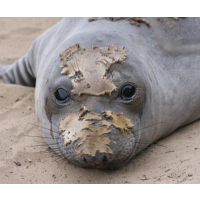Molting Elephant Seals Are Polluting Coastal Areas with Mercury
 Molting elephant seal at Año Nuevo State Park (photo: Frank Balthis)
Molting elephant seal at Año Nuevo State Park (photo: Frank Balthis)
Although humans and their nasty coal habit are responsible for increasing the amount of deadly mercury in marine habits up to four-fold since pre-industrial times, molting elephant seals are making it much worse.
Researchers at the University of California, Santa Cruz published a study this week in the Proceedings of the National Academy of Sciences (PNAS) that said annual “catastrophic molts” by the creatures—once nearly extinct, but now abundant—carry high concentrations of mercury accumulated in their bodies through a process known as biomagnification.
“It’s really interesting to see how wildlife can be exacerbating the cycle,” researcher Jennifer Cossaboon told the Washington Post.
Mercury is converted into methylmercury—a nasty neurotoxin that can damage the brain—by microbes in the seawater. The fish-eating elephant seals pick up the toxic metal from their prey, which easily absorb it from the water or their food in miniscule amounts.
Methylmercury does not break down and becomes more concentrated as it moves upward through the food chain. Concentrations at the top of the chain can be 1 million to 10 million times higher than the levels encountered by fish in the water.
The researchers found the concentration of methylmercury in the seawater at the elephant seal rookery at Año Nuevo State Reserve, midway between Santa Cruz and Half Moon Bay, was eight times as high as other locations along the coast.
Concentrations at Año Nuevo doubled during breeding season. But all that shaking produced nothing compared to molting season, between April 1 and August 31, when concentrations were 17 times higher.
Año Nuevo is one of the largest mainland breeding colonies in the world for the northern elephant seal. They spend half the year far offshore eating contaminated fish and the other half along the coast and on the beach not eating while they offload mercury.
California sea lions, who are also suspected of molting concentrated methylmercury, hang out at the nature preserve, too. Seabirds and other wildlife can bring it in, too.
Scientists have suspected marine molting was a mercury source since the 1970s, according to the Post. But they didn’t have the technology to make the measurements. They do now.
The researchers also tested the elephant seals fur for mercury. Not surprisingly, there was a lot.
So is it a problem? This study didn’t address that. Theoretically, the molted mercury might not be picked up by marine organisms and start working its way up the food chain again. Then again, it could. They did not measure contamination of shellfish, other small vulnerable organisms or wildlife in the vicinity.
The preserve is closed to commercial fishing and Cossaboon told the Post there were no visible signs of distress among living things at Año Nuevo.
–Ken Broder
To Learn More:
Molting Elephant Seals Add Mercury to Coastal Seawater (by Tim Stephens, University of California, San Cruz Newscenter)
The Troubling Reason Why Deep Ocean Mercury Is Reaching California’s Coasts (by Chelsea Harvey, Washington Post)
Mercury in Oceans: Elephant Seals Shed Mercury During Molting Season (by Samantha Mathewson, Nature World News)
Mercury Offloaded in Northern Elephant Seal Hair Affects Coastal Seawater Surrounding Rookery (by Jennifer M. Cossaboon, Priya M. Ganguli and A. Russell Flegal, Proceedings of the National Academy of Sciences)
- Top Stories
- Controversies
- Where is the Money Going?
- California and the Nation
- Appointments and Resignations
- Unusual News
- Latest News
- California Forbids U.S. Immigration Agents from Pretending to be Police
- California Lawmakers Urged to Strip “Self-Dealing” Tax Board of Its Duties
- Big Oil’s Grip on California
- Santa Cruz Police See Homeland Security Betrayal in Use of Gang Roundup as Cover for Immigration Raid
- Oil Companies Face Deadline to Stop Polluting California Groundwater




